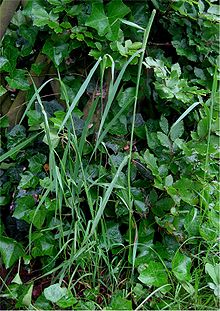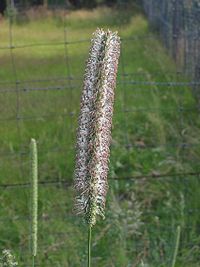- Timothy-grass
-
Timothy-grass 
Habitus, ssp. pratense Scientific classification Kingdom: Plantae (unranked): Angiosperms (unranked): Monocots (unranked): Commelinids Order: Poales Family: Poaceae Genus: Phleum Species: P. pratense Binomial name Phleum pratense
L.Timothy-grass[1] (Phleum pratense), is an abundant perennial grass native to most of Europe except for the Mediterranean region. It grows to 50–150 cm tall, with leaves up to 45 cm long and 1 cm broad. The flowerhead is 7–15 cm long and 8–10 mm broad, with densely packed spikelets. Timothy-grass can be confused with Meadow Foxtail (Alopecurus pratensis) and Purple-stem Cat's-tail (Phleum phleoides).
It is probably so named after Timothy Hanson, an American farmer said to have introduced it from New England to the southern states in the early 18th century.[2][3]
Contents
Subspecies
There are two subspecies:
- Phleum pratense subsp. pratense. Larger, to 150 cm tall. Widespread.
- Phleum pratense subsp. bertolonii. Smaller, to 70 cm tall. Calcareous grassland.
Cultivation and uses
Timothy-grass was unintentionally introduced to North America by early settlers, and was first described in 1711 by John Hurd from plants growing in New Hampshire. Hurd named the grass "hurd grass" but a farmer named Timothy Hanson began to promote cultivation of it as a hay about 1720, and the grass has been known by its present name since then. Timothy has now become naturalized throughout most of the US and Canada.
It is commonly grown for cattle feed and, in particular, as hay for horses. It is relatively high in fibre, especially when cut late. It is considered part of the standard mix for grass hay and provides quality nutrition for horses. Timothy Hay is a staple food for domestic pet rabbits, guinea pigs, chinchillas, and degus, often making up the bulk of their diet. The caterpillars of some Lepidoptera use it as a foodplant, e.g. the Essex Skipper (Thymelicus lineola). It also grows in roadsides and abandoned fields but generally requires nutrient-rich soils.
Its pollen is a common allergen; it has recently been used in small amounts as part of a new hay fever vaccine Grazax, which is designed to recondition the body's immune system so it no longer responds to pollen.
Plants persist through the winter. Dead, straw-colored flowering stems may persist, but only for a short time, and are recognized by the distinctive spike-like inflorescence.
Similarity to Other Species
It is usually confused with Meadow Foxtail Alopecurus pratensis. Timothy flowers later from June until August, whereas Meadow Foxtail flowers from April until June. The spikelets of Timothy are twin hornlike projections arranged in cylindrical panicles, foxtail has a soft, single awn.[4]
References
- ^ Clause 5.3.2.2.3 BS 7370-5
- ^ Merriam-Webster's Collegiate Dictionary, 11th ed., p. 1310.
- ^ Oxford English Dictionary, s.v. timothy grass.
- ^ BSBI Description retrieved 2010-12-1.
Categories:- Poaceae
- Flora of Estonia
- Forages
- Medicinal plants
Wikimedia Foundation. 2010.

